Can you tell the difference between a tasty paddy straw mushroom and a toxic death cap? Emma Shiells talks to the experts about the potentially deadly chemistry hidden in those gills
On a damp and drizzly autumnal morning you may think there are better places to be than foraging in the undergrowth of an orchard, but amateur mushroom hunters are sure to disagree with you. Martin Newcombe, an ecologist and fungi enthusiast, is one of those hooked.
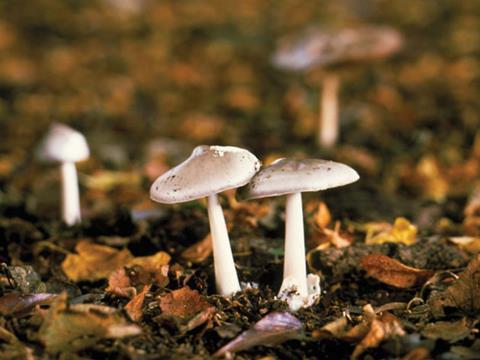
‘The fact that fungi can grow so quickly makes them fascinating,’ says Newcombe; ‘they typically grow in two to three days depending on the environmental parameters.’ For some species like the stinkhorn ‘they can take just a matter of hours,’ he says. The fungal kingdom consists of a wide range of organisms that differ in their size, shape and colour, and in their means of reproduction and spore distribution. You could hold up two mushrooms that are identical to the naked eye, but on closer inspection find that they are two different species entirely – one edible, the other poisonous. It is only when you take a closer look at the spores using a microscope that you can identify the species accurately. ‘The spores are uniquely coloured, patterned and sculpted for each species, where some of them also undergo specific chemical reactions as well,’ explains Newcombe. ‘In the field there is often a limit to what you can do in terms of identification, as sometimes you can only recognise the genus until further tests can be carried out back in the lab. Only once you’ve looked at the spores in more detail and carried out some chemical tests, can you truly identify the species and determine its edibility,’ he adds.
No one really knows what mushroom colours are for, as they are not necessarily warnings. Contrary to popular belief, not all poisonous toadstools are bright red with white spots or warn you by their lurid yellow and green colours. Often poisonous mushrooms look like the edible varieties you might buy in a shop and therein lies the danger for the inexperienced forager.
Death by name, death by nature
‘Death cap is still the commonest cause of [mushroom] poisoning in Europe’ says Newcombe. A notorious fungus, it is part of the Amanita genus that contains around 600 species, some of which are the most highly toxic in the world. It is believed that this genus alone is responsible for approximately 95% of all mushroom poisonings, with 75% of fatal fungal poisonings attributed to death caps (Amanita phalloides) and the related destroying angel (A. virosa).1
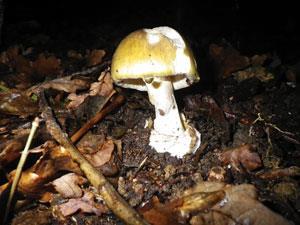
The toxicity of the Amanita species is due to the presence of two groups of toxins known as amatoxins and phallotoxins, both multicyclic peptides. It is believed that the death cap contains six related phallotoxins and five or more amatoxins.2 Geoffrey Kibby, a research associate at the Royal Botanic Gardens at Kew in the UK says that death cap ‘smells like gone-off, sickly sweet honey and they apparently taste really good. But you only need one cap to kill an adult; they are pretty nasty things to eat.’
After someone has eaten the deadly mushrooms, ‘there’s usually a delay between six to 30 hours from ingestion before the symptoms start to present themselves,’ explains Kibby. ‘Typically the person will experience food poisoning-type symptoms: severe abdominal pain, sickness and diarrhea, briefly followed by a day or so of apparent recovery,’ he says. ‘However, the patient will then relapse and deteriorate quite rapidly due to severe renal and liver failure’ often leading to death.
The less-harmful phallotoxins are responsible for the initial gastrointestinal symptoms, but it is the amatoxins that cause the most damage internally. In particular, a-amanitin has a high specificity for RNA polymerase II in the liver. By inhibiting this enzyme it prevents the formation of mRNA and stops protein synthesis, resulting in cell death and subsequent liver failure. When filtered through the kidneys, the toxin can then be reabsorbed into the bloodstream and re-circulated around the body, causing repeated liver and kidney damage.3
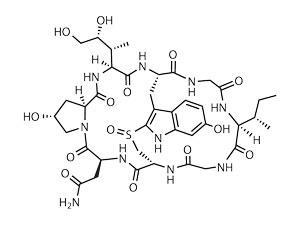
The death rate has certainly decreased over the years, thanks to the advances in treatments, according to Kibby. ‘In the US, they have more cases than we do [in the UK], so they’ve had more opportunity to try different treatments. Standard treatments usually involve large doses of penicillin and vitamin C, as well as keeping the liver and kidneys going,’ he says. Blood can be filtered using carbon-column haemodialysis units or attempting organ transplants in severe cases. ‘The latest chemical they are trialing is called Silibinin, which seems to have very effective results,’ says Kibby. Research shows that the drug works by preventing the uptake of the amatoxins by the liver cells and thereby protecting undamaged liver tissue. It also stimulates DNA-dependent RNA polymerases, resulting in an increase in RNA synthesis.4
But treatment is not always successful and it very much depends on how quickly people are diagnosed after ingestion. Victims who are hospitalised and given treatment almost immediately after ingestion have a mortality rate of around 10%, whereas those admitted 60 hours or more after ingestion have a 50–90% mortality rate.5 In spite of years of detailed research into its toxins, death cap is still the most deadly fungus known, and there’s still no known antidote for humans.
Mistaken identity
Almost all poisoning cases that Kibby has been involved in have been due to misidentification, where immigrants have picked what they thought they recognised from their native country, or based on knowledge passed down from older generations. Recently, Australian news channels reported a case where four people in Canberra accidently poisoned themselves after consuming death cap at a New Year’s Eve party. Two of them later died. They were of Asian descent, and it is believed that they may have mistaken the death caps for edible paddy straw mushrooms (Volvariella volvacea) – a common ingredient used in Asian cuisines.
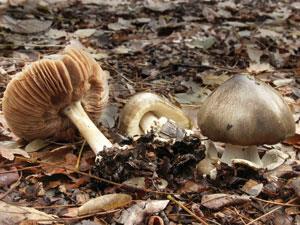
Brett Summerell, a fungi expert from the Royal Botanic Gardens in Sydney, Australia, told ABC News shortly after the deaths that ‘mushrooms that are poisonous in Australia have very close relatives to those that are quite safe to eat and have a very similar appearance to the straw mushroom.’ Newcombe agrees: ‘They’ve come from a culture where mushrooms like that are eaten and so probably thought they recognized them, rather than identified them.’
Since these deaths, the Australian government and the Australian National Botanical Gardens have released a factsheet on death caps.6 It provides detailed descriptions and photographs, as well as possible locations in southern Australia and what symptoms to expect. They emphasise the importance of not confusing death caps with the edible straw mushrooms that are grown and eaten in Asia. Even though the straw mushrooms are not native to Australia, a related species V. speciosa is and looks very similar to straw mushrooms. They have even been found to grow side-by-side with the death caps in some areas of Australia. Each species in the Volvariella genus has a volva at the base of the steam and gills that do not reach the stem – just like the death cap. As the guidebook3 says, ‘great care should be taken in identification to avoid confusion with the deadly white-spored Amanitas’.
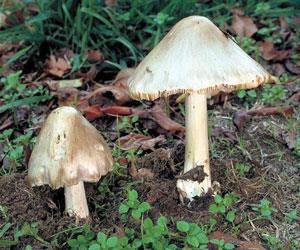
‘The greenish form of death cap does look like the paddy straw mushroom,’ says Kibby. ‘Even the bulbous bag at the base of the stem can be present on the paddy straw mushroom so that wouldn’t have alerted them initially.’ The only way to tell them apart is by looking at their spores, according to Kibby: ‘The paddy straw mushrooms have pink spores whereas the death cap have white spores.’ There are also chemical tests that can be carried out: adding sulfuric acid to the mushroom’s stem or gills will turn black if it is a death cap. The Meixner test uses concentrated hydrochloric acid and newspaper to determine the presence of the deadly toxin a-amanitin.7
As an experienced mycologist, Kibby is often called upon to help with mushroom poisonings via the National Poisons Information Service (NPIS), which is a clinical toxicology service available for healthcare professionals in the UK. In 2011, the NPIS saw 257 poisoning cases linked to eating mushrooms in the UK, but without any deaths in over four years. That was until last year, when Kibby’s expertise was urgently needed as a married couple were hospitalised after eating mushrooms suspected to be death caps. ‘They [NPIS] got the son to go down to the bottom of the garden and photograph the mushrooms for me, they also packaged some up and sent them to me in London that same afternoon,’ explains Kibby. ‘As soon as I opened the package I could smell that gone-off honey smell that is so typical for A. phalloides [death cap].’
Sadly the woman died from multiple organ failure, but her husband survived having only consumed a very small amount of the fungi. ‘She was doubly unlucky, as it was the end of the year so they shouldn’t have been there in the first place, and they were albino in colour; the least typical colour form [for death caps],’ says Kibby. ‘Apparently, she had identified them as edible mushrooms using a field guide,’ he adds.
Metal recycling
Unfortunately, even non-poisonous fungi can be pretty bad for you, because they are very good at recycling. They are non-photosynthetic organisms, gaining energy and nutrients for their biosynthetic pathways through the degradation of other plants and matter, which means they can easily absorb trace elements from their local environment.
Fungi collected near former smelters, landfill sites and land treated with sewage sludge can accumulate significant quantities of metal ions, such as cadmium, mercury, lead, copper and chromium. Even worse, high levels of radioactive caesium-137 isotope have been found in mushrooms. ‘It was only a few years ago that the British government stopped monitoring toadstools generally from the fallout at Chernobyl,’ says Newcombe. Kibby believes that there are still some areas of far eastern Scandinavia where picking mushrooms is not advisable, due to the radiation found in them.
Newcombe once harvested mushrooms growing near a disused factory that was an old iron smelter. ‘You could taste the iron in them,’ he says. ‘I sent samples off to be tested and, sure enough, there was more iron in them than there should have been.’ And mushrooms that grow near roadside edges can absorb lead from passing vehicles. The mushrooms themselves might be edible, but once they have absorbed metals from their surrounding environment they can become poisonous due to the high concentration of heavy metals found inside them.
Reader beware
In the UK, collecting mushrooms is more of an occasional pastime, whereas in other cultures people pick them for everyday consumption. In mainland Europe, pharmacists can be asked to help identify them. ‘Problems arise when people try to identify edible mushrooms using only a guidebook. If you want to eat wild mushrooms, you’ve got to go on organized forays with someone that knows what they are doing,’ says Kibby. ‘No matter how good the field guide is, it can’t possibly cover all colour variations and eventualities. It seems silly to risk your life when you can go to your local deli and buy exotic mushrooms there,’ he says.
Kibby says that, contrary to what you might expect, most poisonings happen not from picking really weird-looking mushroom, but from the most normal looking ones, such as paddy straw mushrooms. ‘If only people would stick to really weird and wonderful mushrooms like some Boletus,’ he says. ‘Then you can’t go wrong as you can’t mistake them for anything else.’
Hail Caesar!
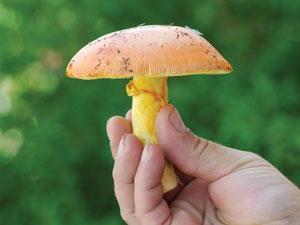
Not all mushrooms from the Amanita genus are bad for your health; some of its species are edible, like the glorious Amanita caesarea with its orange cap and yellow stem and gills. Known in English as Caesar’s mushroom, it has been prized since Roman times and is not easily confused with other Amanita species, thanks to its vibrant colouring. It has yet to be found in the UK, but grows in warmer climates like southern Europe and North Africa. It was said to be a favorite of the Roman emperor Claudius and has been found growing along old Roman roads. Many ancient historians believe that Claudius died from mushroom poisoning, murdered by his own wife Agrippina in 54 AD. It has been widely speculated that death caps were used as the poison, but it is now considered to be unlikely given the short timeframe reported between him getting sick and dying.8
Kibby has tried some edible Amanitas, ‘but even then my heart was in my mouth,’ he adds. He has eaten A. rubescens, which although edible after cooking, are poisonous if eaten raw. ‘It did taste delicious although I couldn’t help but watch for symptoms over the next few hours,’ he says.
Updated 19 March with clarified alpha-amanitin structure image; updated 4 April with clarified image captions
References
1 J R Hanson, The chemistry of fungi, RSC Publishing, Cambridge, 2008
2 G Kibby, Guide to mushrooms of Britain and Europe, Octopus Publishing, 2006
3 R Phillip, Mushrooms and other fungi of Great Britain and Europe, Pan, London, 1981
4 K Hruby, G. Csomos, M Fuhrmann and H Thaler, Human Toxicology 1983, 2, 183 (DOI: 10.1177/096032718300200203)
5 The Bad Bug Book, US Food and Drug Administration, 2nd edn, 2012, p200 http://1.usa.gov/XO6DF6
6 Australian National Botanical Gardens http://bit.ly/10gSeRl
7 M Beuhler, DC Lee and R Gerkin, Ann. Emerg. Med., 2004, 44, 114 (DOI: 10.1016/j.annemergmed.2004.03.017)
8 V J Marmion and T E J Wiedemann, J. R. Soc. Med., 2002, 95, 260 (DOI: 10.1258/jrsm.95.5.260)
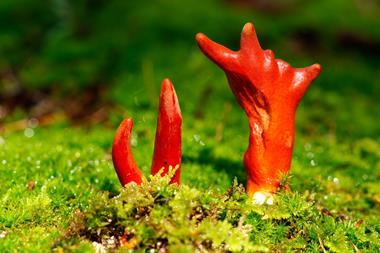
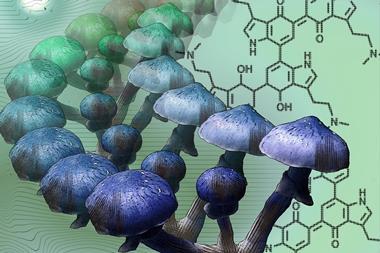
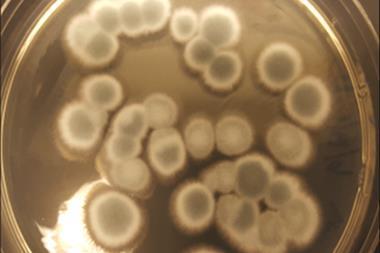



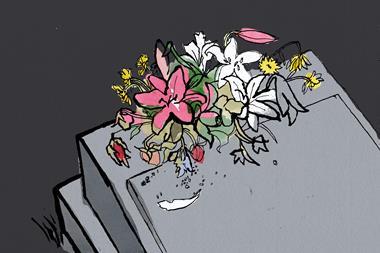





No comments yet